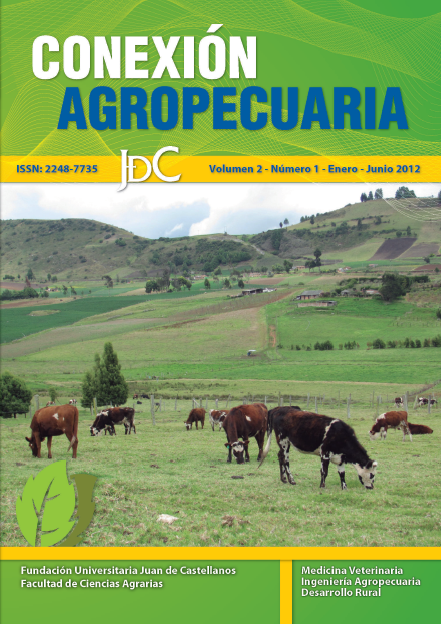Keywords:
Rearing calves, lift system, stake, nursery, daily weight gainAbstract
The breeding of replacement heifers constitutes one of the biggest challenges of competitive modern farming, especially in the dairy industry, where profitability is given a priority attention. This study compared two rearing systems for Holstein heifers on the “villa María” farm in Firavitoba (Boyacá - Colombia). This town is located in the highland tropic. For the study, 20 years old calves were randomly chosen. They were divided into two equal groups with the same food conditions and under the same study standards. This was done for a period of six months. Two methods of breeding were tested: grazing and stabling. In order to do a respective testing, the calves were weighed with an electric scale and a cattle tape measure for an interval of fifteen days. The data obtained were compared and analyzed to know which breeding method was the most effective. The results showed that the use of the stabling system produced a gain weight increase in the tested subjects, as well as maintenance of management and health conditions that were not observed in other types of rearing systems. Therefore, this system represents a better response in terms of animal wellbeing.
Downloads
References
Andrade, Roy; Manrique A, Fred; Peters, Kart. (2008). Características productivas y de gestión de fincas lecheras en Boyacá, Revista MVZ Córdoba, Vol. 13, Núm. 2, mayo-agosto, 2008, pp. 1333-1342
Delgado A. (2001). Manejo de terneraje. Rev. Inv. Vet. Perú., 12(2): 33-35. Fattore, R. (2009). Cría de terneras para remplazo. http://www.engormix.com/MA-ganaderia-leche/manejo/articulos/cría-terneras-reemplazo-t5/124-p0.htm ( )
Iglesias, J.M., Matías, C., Pérez, A. (2003). Cría de hembras bovinas en desarrollo en condiciones de silvopastoreo. Estación Experimental de Pastos y Forrajes “Indio Hatuey”. Pastos y Forrajes Vol. 26, Núm. 1.
Lanuza, F. (2006.). Crianza de terneros y reemplazos de lechería. Manual de producción de leche para pequeños y medianos productores. Instituto de Investigaciones Agropecuarias (INIA). Centro Regional de Investigación Remehue, Osorno, Chile, 109-128.
Lezzaca, M.; Kleemann, G.; Lobo, C. y Serrano, G. (1992). Desarrollo de esquemas de monitoreo en explotaciones bovinas y porcinas. Experiencias en Colombia. CICADEP (Bogotá). 16 p. En: Ángel S. & Rivera B. 2004. Desarrollo metodológico para analizar dinámicamente las fincas ganaderas doble propósito con información estática. CONDESAN.
Patarroyo E. (06 de marzo de 2011). Firavitoba. Recuperado el 06 de marzo de 2011, de Firavitoba: www.tutiempo.net/tierra/Colombia/Firavitoba-CO023127.html
Wattiaux, M. A. (2005). Crianza de terneras-Del nacimiento al destete. Visión general prácticas de manejo. Instituto Babcock para la Investigación, pp. 105 - 108.





